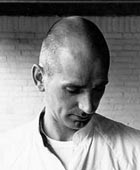Guido Geelen was awarded the Dr A.H. Heineken Prize for Art 2000 for the unorthodox and innovative way in which he uses the traditional material of clay.
Geelen, who prefers to be called a creator of sculptures, creates images in which ceramics form an important element. These images are often constructed from ceramic reproductions of a wide variety of everyday objects. Guido Geelen has, for example, created a ceramic sculpture composed of dogs, car tyres, vacuum cleaners, televisions and computers, all made of red clay compacted together. By organising these items in a particular way and then stacking them on top of one another, Guido Geelen has created a ceramic wall which fascinates viewers despite – or perhaps because of – its seemingly morbid character. The Netherlands has a rich tradition in ceramic art, ranging from the centuries-old Delftware industry to the innovative Dutch pottery from around 1900 (when independent potters first began to flourish) and right up to the revolutionary ceramic work being produced in our own day. This partially motivated the award of the prize to Guido Geelen for his entire oeuvre.
Biography
Guido Geelen was born in Thorn, the Netherlands, in 1961. He attended the Institute for Draughtsmanship, Craftsmanship and Textiles (TEHATEX) in Tilburg and went on to study at the Academy of Fine Arts for two years. Guido Geelen was awarded the incentive prize for applied art by the Amsterdam Fund for the Arts in 1988, the Charlotte Köhler Prize for Sculpture in 1989, and the incentive prize for fine art by the Amsterdam Fund for the Arts in 1990. Guido Geelen’s work can be viewed at the Stedelijk Museum of Modern Art in Amsterdam, the PTT Art and Design Collection in The Hague, the Kruithuis Museum for Contemporary Art in ‘s-Hertogenbosch, the Noord Brabant Museum in ‘s-Hertogenbosch, the Kröller-Müller Museum in Otterlo, the Boijmans van Beuningen Museum in Rotterdam and the De Pont Museum in Tilburg.
